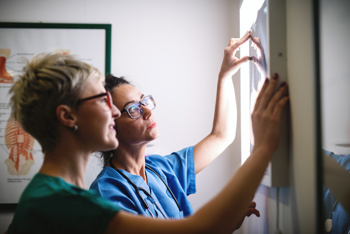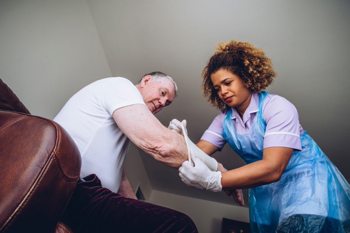
What is Body Mapping?
At its core, what is body mapping? It’s a method of recording marks, injuries, wounds, or other changes on a simple diagram of the human body. Staff can log the type of issue, its exact location, date and any notes on how it happened or how it’s healing.
It’s used widely in health and social care, from hospitals to residential settings and home care services. A body mapping example might be recording a pressure ulcer, a bruise following a fall, or a surgical wound. After this, ongoing entries are expected as this can show whether the issue is improving or deteriorating.
For carers and nurses, body maps provide an immediate, visual way to communicate important information. Instead of reading through lengthy notes, anyone picking up a case can see at a glance where a wound is, what stage it’s at and what actions have already been taken.

Why Body Mapping in Care Happens
The role of body mapping in care shouldn’t be overstated. Accurate body maps are key for various things, including:
- Continuity of care – Ensuring all staff have consistent information, especially in shift-based environments.
- Health monitoring – Keeping track of wounds, infections or skin conditions over time.
- Regulatory compliance – Providing evidence for inspectors that issues are being monitored and managed appropriately.
- Safeguarding – Quickly identifying unexplained marks or injuries and escalating concerns.
In fact, best practice guidance such as that from the body mapping NHS toolkit highlights the importance of using visual diagrams alongside narrative notes. By doing so, providers reduce the risk of missing important details and can demonstrate a proactive, transparent approach to care.
Practical Benefits for Providers
For care providers, the practical benefits of digital body mapping go beyond compliance. They save time as people will no longer have to search through paper files and communication will be improved as all staff have access to the same up-to-date records. Issues are spotted earlier, reducing risks of escalation and better outcomes. Finally, providers can have peace of mind knowing they can demonstrate a robust system to inspectors, regulators and families alike.
Body Mapping NHS
The body mapping NHS approach is often used as a benchmark in the wider sector. NHS toolkits emphasise that body maps should always be completed alongside written records and reviewed regularly to ensure accuracy. Best practice also includes:
- Using body maps for both safeguarding and health monitoring.
- Ensuring all staff are training in how to complete them.
- Linking body mapping directly to care planning and risk management.
These principles apply equally in social care settings. By adopting digital systems, providers can embed these practices more effectively, ensuring they’re consistently applied and easily evidenced.
Body Mapping in Care Homes
Body mapping in care homes is especially critical. Residents may be more vulnerable to falls, pressure ulcers, or skin tears and staff turnover or shift changes can mean different people are providing care each day. A clear body map ensures continuity, so nothing slips through the cracks.
When carers log issues consistently, it also gives managers a dataset they can use to monitor patterns. For example, if multiple residents are developing pressure sores in the same area, this may flag a training need or highlight issues with equipment.
Whether it’s wound healing, safeguarding, or medication side effects, body mapping for care homes provides both a record and a learning tool. It’s no surprise regulators place so much importance on detailed, accurate recording.

How Can Care Management Software Help with Body Mapping?
So, how can care management software help with body mapping? In several powerful ways:
- Accuracy and clarity – Carers can log marks or injuries directly on a digital body map, removing issues with handwriting or interpretation.
- Real-time updates – Information is captured instantly and shared across the care team, ensuring everyone sees the latest record.
- Audit trails – Software automatically records who added or updated entries and when, providing strong evidence for inspections.
- Integration – Digital body maps can link directly to care plans, risk assessments and incident reports, giving a full picture of an individual’s care.
- Reporting – Managers can run reports across all residents or care recipients to identify patterns, risks or training needs.
In essence, software takes the benefits of body mapping in care homes and scales them, making the process more efficient, more secure and more valuable as a tool for improvement.
Paper vs. Digital Methods
Historically, many providers have used paper-based body maps, stored in care plans or nursing files. While this works in principle, it often creates challenges such as:
- Maps can be misplaced or filed incorrectly.
- Handwriting may be unclear or inconsistent.
- Updates aren’t always logged in real time.
- Sharing information between teams or locations is difficult.
- Audit trails are harder to prove during inspections.
In short, paper maps increase the risk of errors and make compliance more difficult. That’s where digital systems step in.
Body Mapping Example
Let’s take a quick look at a body mapping example to see the difference in paper vs. digital methods. So, imagine a resident in a care home develops a bruise on their arm after a minor fall. On paper, this might be recorded with a mark on a printed diagram and a brief note. But if the paper is misplaced, other carers may not know about it and may treat the bruise as negligence or abuse.
However, with digital body mapping, the bruise is logged instantly on the person’s profile. Then a notification will be sent to the care team alongside a safeguarding alert that can be triggered automatically if needed. Over time, follow-up notes and photos can be added, which allows carers to see any changes in the bruise and healing delays.
When an inspector visits, the service can show a complete history of the injury, actions taken and current status all in once place. This doesn’t just meet regulatory expectations, but it also reassures families and demonstrates a culture of transparency, which is often highly valued within the care sector.

The Access Group Software Solution
We’ve seen that while traditional methods have their place, digital tools take body mapping in care to the next level. They ensure accuracy, improve communication, and make compliance simpler. Most importantly, they give carers more time to focus on delivering the compassionate, person-centred support that matters most.
That’s where we at The Access Group comes in. Our Access Care & Clinical software includes digital body mapping for care homes and wider care settings. With intuitive, easy-to-use tools, carers can record and update body maps in real time, link them to care plans, and generate reports for managers or inspectors. Audit trails and integration with other records mean you’ll always have the evidence you need to demonstrate compliance and high-quality care.
By choosing Access Care & Clinical, you’re not just adopting a system for body mapping, you’re also investing in a comprehensive care management solution that supports safety, transparency and better outcomes across your service. To learn more, get in touch with our team today and see how digital body mapping can make a real difference in your care delivery.

 AU & NZ
AU & NZ
 SG
SG
 MY
MY
 US
US
 IE
IE

